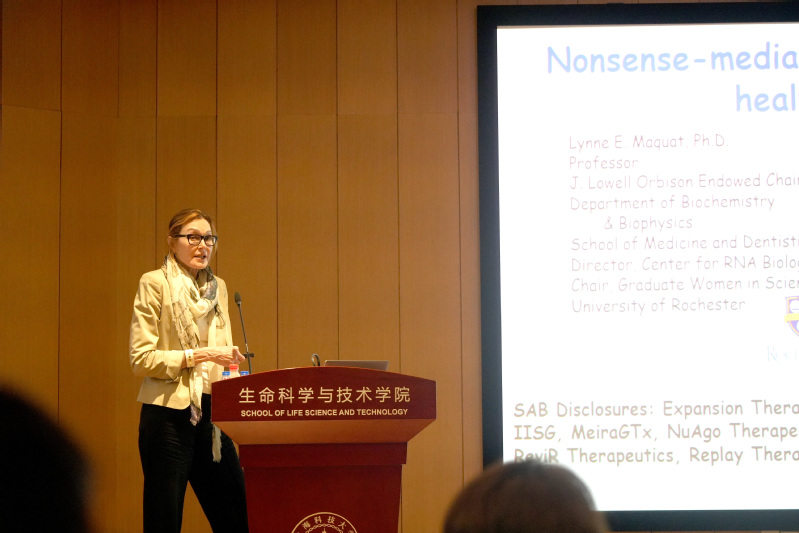2023年11月10日星期五,Wolf奖获得者、罗切斯特大学RNA生物研究中心创始人Lynne Elizabeth Maquat教授在刘如娟教授的盛情邀请下,来上海科技大学生命学院参加生命科学系列讲座,为师生做了题为“Nonsense-mediated mRNA decay in human health and disease”的学术报告。

1981年, Maquat教授在研究β-地中海贫血症过程中发现无义突变的患者体内的pre-mRNA无法有效地经历剪接变为成熟的mRNA,发现含有提前终止密码子(Pre-termination condon,PTC)的mRNA是不稳定的,引发mRNA降解。这启发了Lynne Elizabeth Maquat继续研究PTC引发mRNA降解的机制,并最终发现并解析了pre-mRNA在剪接过程和mRNA出核转运过程中会检查成熟的mRNA并识别PTC的分子机制。在确定PTC引发mRNA降解(即nonsense-mediated mRNA decay,NMD)后,Maquat教授团队发现了并确定了负责引发NMD的蛋白质复合物——外显子连接复合物(Exon-junction complex,EJC)。随后,鉴定到EJC会在识别到PTC后触发UPF1的磷酸化,磷酸化的UPF1直接与eIF3相互作用并抑制mRNA的翻译起始,使含有无义突变的mRNA被降解。
Maquat教授团队还发现一个惊人的事实——细胞内大约有三分之一的mRNA是错误的,含有无义突变,这源于剪接过程或3’端形成过程中产生的,而NMD机制负责对细胞核产生的mRNA进行质量监控并清理身体内错误的mRNA,有效地避免翻译产生有毒蛋白质。在发现NMD的机制之后,Maquat教授团队致力于寻找NMD的功能和生物学意义,迄今为止,发现NMD会和细胞核内的选择性剪接(alternative splicing,AS)耦合调节细胞内的RNA结合蛋白质(RNA-binding protein,RBP)的丰度;NMD在细胞响应化疗药物等外界刺激中也发挥重要作用。
在人类疾病与健康方面,Maquat教授团队发现UPF1会与脆性X智力低下蛋白质(Fragile X mental retardation protein ,FMRP)有直接相互作用,而编码FMRP蛋白质的基因突变是引起脆性X染色体综合征(Fragile X syndrome)的关键致病因素。Maquat教授团队发现FMRP结合mRNA上的富含GC序列和结构化序列,使mRNA与细胞质内的poly(A)结合蛋白质结合,保护mRNA并促进mRNA的翻译,这在神经元发生过程中的突触形成至关重要。而在FMRP缺陷的脆性X染色体综合征患者体内的NMD发生过度活化,导致细胞内翻译缺陷,为揭示脆性X染色体综合征的发病机制提供了研究方向。
【about Lynne Elizabeth Maquat】
Dr. Lynne Maquat is the J. Lowell Orbison Endowed Chair and Professor of Biochemistry & Biophysics who holds concomitant appointments in Pediatrics and in Oncology, Founding Director of the Center for RNA Biology, and Founding Chair of Graduate Women in Science at the University of Rochester, Rochester, NY. After obtaining her PhD in Biochemistry from the University of Wisconsin-Madison and undertaking post-doctoral work at the McArdle Laboratory for Cancer Research, she joined Roswell Park Cancer Institute before moving to the University of Rochester Medical Center. Dr. Maquat’s research focuses on the molecular basis of human diseases, with particular interest in mechanisms of mRNA decay. Dr. Maquat discovered nonsense-mediated mRNA decay (NMD) in human diseases in 1981 and, subsequently, the exon-junction complex (EJC) and how the EJC marks mRNAs for a quality-control “pioneer” round of protein synthesis. She also discovered Staufen-mediated mRNA decay, which mechanistically competes with NMD and, by so doing, new roles for short interspersed elements and long non-coding RNAs. Additionally, she has defined a new mechanism by which microRNAs are degraded, thereby regulating mRNAs so as to promote the cell cycle. One of her current interests focuses on the development of therapeutics for diseases that she has shown manifest hyperactivated NMD, including the most common single gene cause of intellectual disability and autism, Fragile X Syndrome. Maquat is an elected Fellow of the American Association for the Advancement of Science (2006); an elected Member of the American Academy of Arts & Sciences (2006), the National Academy of Sciences (2011), and the National Academy of Medicine (2017); and a Batsheva de Rothschild Fellow of the Israel Academy of Sciences & Humanities (2012-3). She received the William C. Rose Award from the American Society for Biochemistry & Molecular Biology (2014), a Canada Gairdner International Award (2015), the international RNA Society Lifetime Achievement Award in Service (2010) and in Science (2017), the FASEB Excellence in Science Award (2018), the Vanderbilt Prize in Biomedical Science (2017), the Wiley Prize in Biomedical Sciences from Rockefeller University (2018), the International Union of Biochemistry and Molecular Biology Medal (2019), the Wolf Prize in Medicine from Isreal (2021), the Warren Alpert Foundation Prize from Harvard Medical School (2021), and the Gruber Genetics Prize from the Gruber Foundation and Yale University (2023). Maquat is well-known for her efforts to promote women in science.


